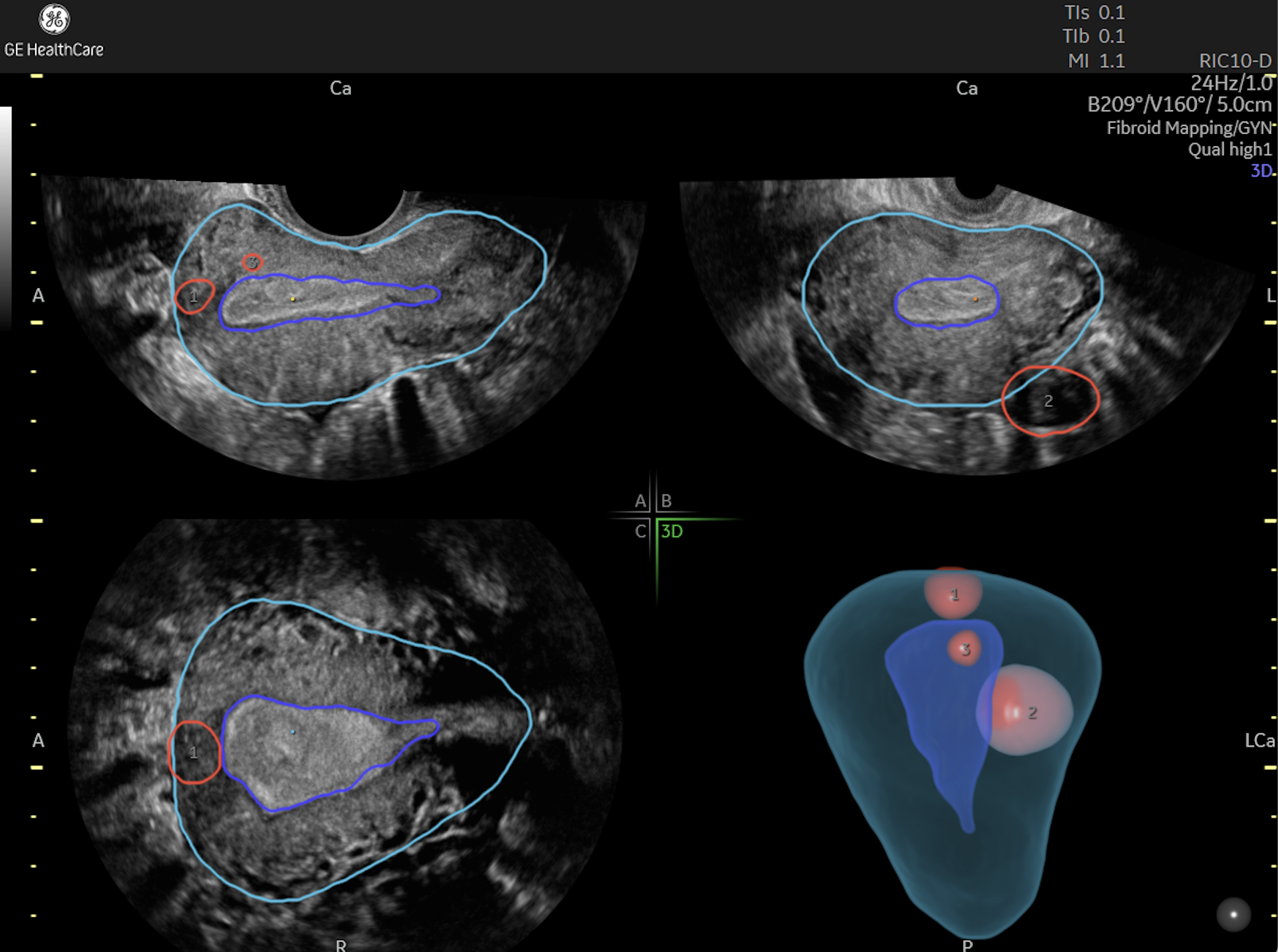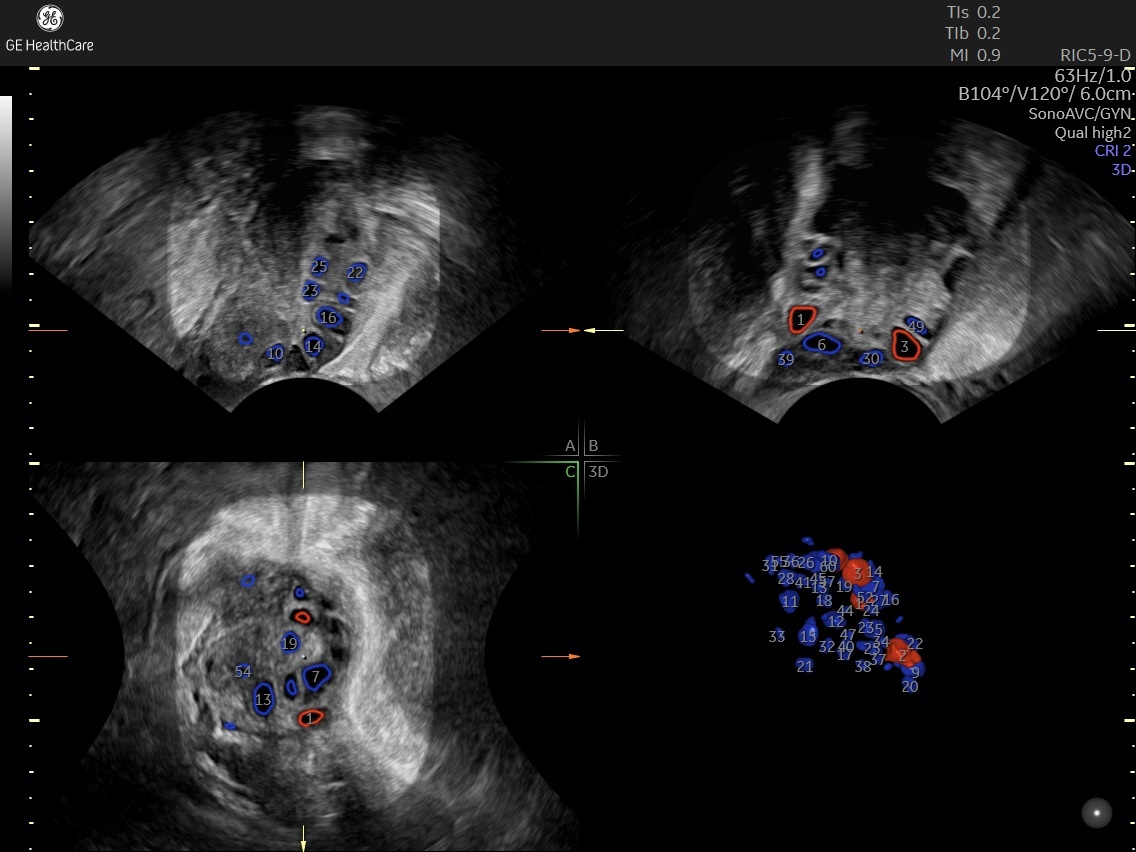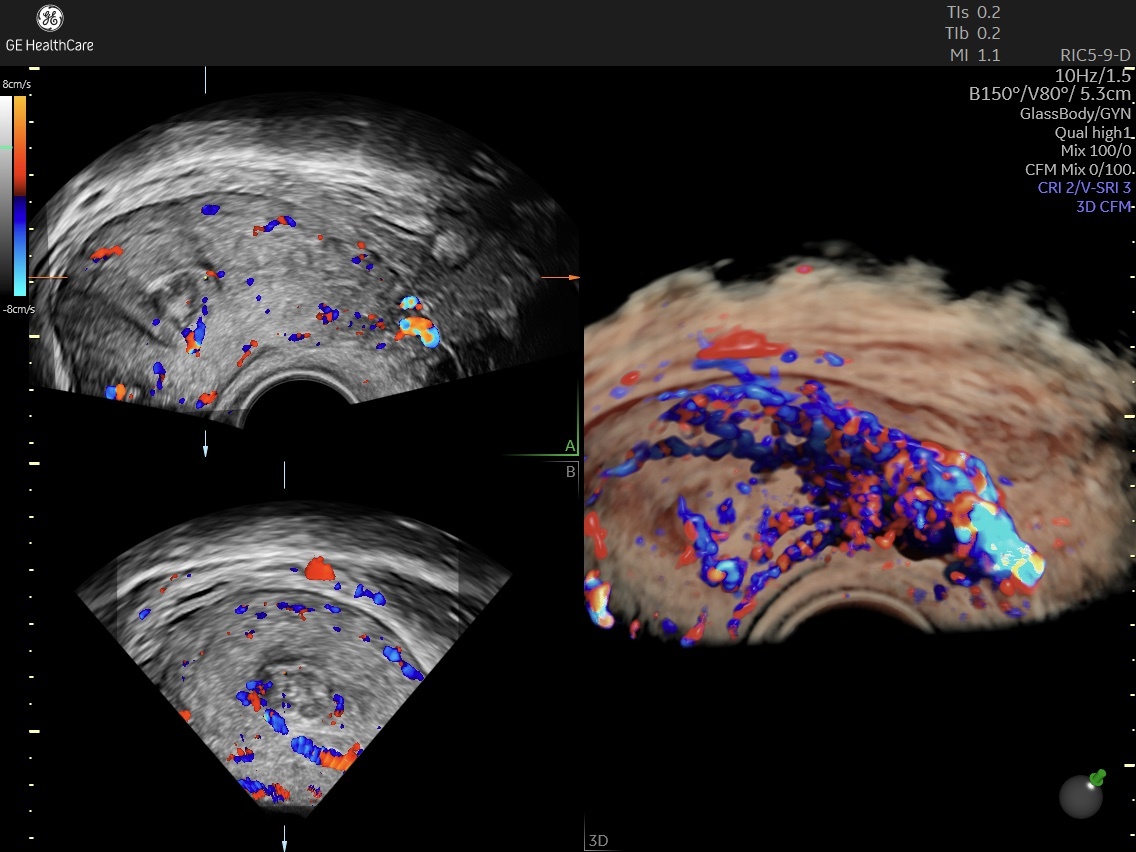Color Doppler ultrasound represents sound waves with a scale of different colors to assess the speed and direction of blood flow to an organ. The extra information it provides can indicate various potential issues, such as ovarian torsion, and even help classify ovarian tumors.
Your patients struggling to get pregnant want detailed answers as to why they are infertile or sub fertile. Adding color Doppler to 3D ultrasound during an infertility workup can provide more insights for both patients and reproductive specialists.
Seeking the Causes of Infertility With Doppler
A wide range of gynecologic issues can contribute to infertility, many of which can be evaluated with ultrasound. Fibroids, endometriosis, adenomyosis, polycystic ovary syndrome (PCOS) and uterine and ovarian abnormalities can all be seen with ultrasound. This allows the clinician to uncover or rule out what may be causing any difficulty in getting pregnant or carrying a pregnancy to term.

Fibroid shown on Voluson™ Expert 22 using Fibroid Mapping
Adding color flow Doppler to 3D ultrasound adds more to the picture. Together with antral follicle count and measurements of ovarian reserve, Doppler also aids in making decisions about in vitro fertilization (IVF) or other fertility treatments. Doppler also gives insight into ovulation to evaluate the use of ovulation-stimulating medications.

Antral follicle count using Voluson™ SonoAVC™antral
Specifically, color Doppler uses uterine artery indices, including resistance index (RI) and pulsatility index (PI), which have a high sensitivity and specificity to diagnose uterine blood flow impedance. This also helps predict the likelihood of miscarriage. RI and PI indices tend to be higher in women with a potential abortion, missed abortion or incomplete abortion, according to research published in the Egyptian Journal of Radiology and Nuclear Medicine. This research also suggests that RI and PI tend to be higher in women with unexplained infertility than in fertile women.
Measuring Blood Flow with Doppler
Blood flow to the ovaries, uterus and endometrium change throughout the menstrual cycle. Blood flow indices can help detect problems with implantation, uncover the cause of unexplained infertility, and predict ovulation to help time any assisted reproductive technology interventions. Here are a few measures that can be taken with Doppler during an infertility assessment.
Endometrium
The shape and thickness of the endometrium can predict ovulation. Adequate blood supply to the endometrium is essential for implantation, and assessment of this blood flow may help predict IVF outcomes.
Blood flow also supports endometrial receptivity. According to research published in Ultrasound Imaging in Reproductive Medicine, measuring Doppler flow of uterine vessels has high sensitivity and specificity compared to measuring endometrial thickness and pattern.
Measuring uterine blood flow with Doppler ultrasound also helps diagnose and evaluate the effects of PCOS on fertility. Women with PCOS tend to have reduced uterine and endometrial blood flow and higher values of RI and PI. This can indicate reduced receptivity, making implantation more difficult. Finally, endometrial blood flow is also important during IVF to ensure receptivity for embryo transfer.

Endometrium blood flow
Uterine and Ovarian Masses
Many patients have benign fibroids that have no effect on fertility. Still, the size and location of fibroids can lead to infertility or subfertility. People of more advanced maternal age who are struggling to get pregnant may also have adenomyosis, which can be difficult to distinguish from fibroids on ultrasound. Adding Doppler to 3D ultrasound allows you to see the difference between the two and plan treatment accordingly.
When using Doppler ultrasound, a fibroid is often surrounded by a rich vascular supply, which shows on ultrasound as a "ring of fire," or circular flow pattern. Adenomyomas, on the other hand, have a trans lesional blood vessel pattern. With 3D ultrasound, the clinician can determine the size and location of fibroids or adenomyosis to determine their effect on fertility and plan a treatment course.
Cysts and other masses are also detected by Doppler ultrasound. The blood flow around these masses helps determine whether the mass is a benign cyst or a potential tumor, which has increased vascularity.
Tubal Patency
Tubal pathology is one of the leading causes of subfertility in women, according to Ultrasound Imaging in Reproductive Medicine. Doppler with saline-infused sonography shows how the liquid flows through the fallopian tubes and into the uterus. Lack of color signals on Doppler ultrasound indicates a blockage in the tube. Doppler with contrast ultrasound can also illustrate tubal patency and the presence of blockages.
Hydrosalpinges are a common type of distal tubal occlusion that leads to infertility. They have distinct features on ultrasound, including incomplete septation, short linear projection, tubular shape and the presence of a visible "waist."
Color Doppler for Infertility Assessment
Doppler is useful both when the cause of fertility is known and when it is not yet known. Adding Doppler to your fertility assessments provides more details on the patient's menstrual cycle, ovulation and ovarian reserves, which can help time IVF.
For women with unexplained infertility, Doppler indices may provide more details on uterine receptivity or the presence and size of fibroids. Using color Doppler ultrasound to monitor the patient's cycle also provides more details of potential challenges. Corpus luteum formation can be seen on Doppler, as can luteal phase defects based on the blood flow in the corpus luteum. Visualizing changes throughout the menstrual cycle not only provides insight into infertility causes, but also helps in planning interventions.
During a fertility assessment, your patients want answers and a path forward. Color Doppler ultrasound is one more powerful tool to give your patients answers to their concerns. Providing them with as much information as possible can help ease anxiety and, ultimately, empower them to take the next steps.





